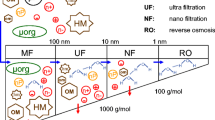Summary
Humic substances (HUS) are present in all aquatic systems. Their analytical identification and quantification suffers from a lack of knowledge of the general structure. Therefore sum- and group-parameters, such as dissolved organic carbon (DOC) or carboxylic groups, are of great importance for the characterization of humic substances and their reactivity. Humic/metal interactions can be determined under defined reaction conditions. Model experiments are helpful to confirm these results. Complexation capacities (CC) reflect the maximum of metal binding ability for the unit of HUS. The CC in respect to Cu(II) was determined by the titration of the initial amount of Cu(II) (10 μmol/l) with a HUS-solution of known DOC at a pH-value of 6.8. Differential pulse polarography with a dropping mercury electrode was used for detection. The results (2 to 7 μmol per mg DOC) suggest complex formation by oxygen containing functional groups in addition to nitrogen containing ones. Iron, strongly bound to HUS even at pH 2.2, shows some similarities to Fe(III) in hydroxamic acid compounds. Coordination of Hg(II) onto thio-groups of the humics can be confirmed by means of photochemical decomposition reactions using model ligands and natural samples. CCs for isolated humics suggest that in most natural aquatic systems there is an excess of organic ligand functions compared with the dissolved heavy metals. CCs, however, should only be discussed in close connection with the determination method applied and the reference metal concerned.
Zusammenfassung
Huminstoffe (HUS) sind in allen Gewässern vorhanden. Ihre analytische Identifizierung und Quantifizierung leidet an der mangelnden Kenntnis der Gesamtstruktur. Zur Charakterisierung der Gewässerhuminstoffe und ihrer Reaktionsfähigkeit sind daher Summen- und Gruppenparameter besonders wichtig. Eine Isolierung aus Gewässern ist für die Aussagekraft der Werte und ihre Reproduzierbarkeit wesentlich. Die Wechselwirkung mit Metallen läßt sich unter definierten Reaktionsbedingungen bestimmen und durch gezielte Modellversuche überprüfen. Unter Komplexierungskapazität (CC) ist hierbei die nach einem bestimmten Verfahren ermittelte maximale Metallbindung je Huminstoffeinheit zu verstehen. Die auf Kupfer bezogene CC wird durch Titration einer vorgelegten Cu(II)Menge (10 μmol/l) mit einer Huminstofflösung bekannter DOC-Konzentration bei einem pH-Wert von 6,8 bestimmt. Die differentielle Pulspolarographie mit einer tropfenden Quecksilberelektrode wird als Detektor verwendet. Die Ergebnisse (2 bis 7 μmol pro mg DOC) lassen für die Komplexbildung neben stickstoffhaltigen Gruppen eine Beteiligung sauerstoffhaltiger Gruppierungen vermuten. Das auch bei einem pH-Wert von 2,2 noch fest in den HUS gebundene Eisen zeigt eine gewisse Ähnlichkeit mit dem in Hydroxamsäurekomplexen gebundenen Fe(III). Die koordinative Bindung von Hg(II) and Thiogruppen der HUS kann mit Hilfe photochemischer Abbaureaktionen mit Modell-Liganden und natürlichen Proben bewiesen werden. Die für natürliche HUS bestimmten Komplexierungskapazitäten zeigen, daß in Gewässern meist mit einem Überschuß organischer Ligandfunktionen gegenüber den gelösten Schwermetallen zu rechnen ist. Komplexierungskapazitäten sollten jedoch nur im Zusammenhang mit der angewandten Bestimmungsmethode und dem jeweiligen Bezugsmetall betrachtet werden.
Similar content being viewed by others
Literatur
Sontheimer H, Gimbel R (1977) Gas-Wasserfach, Wasser, Abwasser 118:165–173
Gjessing ET (1976) Physical and chemical characteristics of aquatic humus. Ann Arbor Sci Publ, Ann Arbor
Rook JJ (1977) Environ. Sci Technol 11:478–482
Gamble S, Schnitzer M (1973) In: Singer PC (Hrsg) Trace metals and metal-organic interactions in natural waters. Ann Arbor Sci Publ, Ann Arbor
Christman RF, Gjessing ET (Hrsg) (1983) Aquatic and terrestrial humic materials. Ann Arbor Sci Publ, Ann Arbor
Johannsen K-H (1974) Acta Hydrochim Hydrobiol 2:65–76
Ziechmann W (1980) Huminstoffe. Verlag Chemie, Weinheim
Stevens FJ (1982) Humus chemistry. John Wiley, New York
Eberle SH, Schweer KH (1973) Vom Wasser 41:27–44
Hoffmann MR, Yost EC et al. (1981) Environ Sci Technol 15:655–661
Khairy AH, Ziechmann W (1981) Z Pflanzenernähr Bodenk 144:407–422
Mantoura RFC, Riley JP (1975) Anal Chim Acta 76:97–106
Frimmel FH, Niedermann H (1980) Z Wasser Abwasser Forsch 13:119–124
Hart BT (1981) Environmental Technol Letters 2:95–110
Branica M, Novak DM, Bubić S (1977) Croat Chim Acta 49:539–547
Nürnberg HW (1978) in: Ahlberg P, Sundelof L-O (Hrsg) Structure and dynamics in chemistry. Almquist & Wiksell, Stockholm
Plavsić M, Krznarić D, Branica M (1982) Mar Chem 11:17–31
Shuman MS, Cromer JL (1979) Environ Sci Technol 13:543–545
Frimmel FH, Immerz A, Niedermann H (1983) J Environ Anal Chem 14:105–115
Frimmel FH, Sattler D (1982) Vom Wasser 59:335–350
Frimmel FH, Niedermann H (1980) Z Wasser Abwasser Forsch 13:119–124
Senesi N, Griffith SM et al. (1977) Geochim Acta 41:969–976
Lakatos B, Korecz L, Meisel J (1977) Geoderma 19:149–157
Frimmel FH, Geywitz J, Quentin K-E (1981) Vom Wasser 57:185–198
Frimmel FH, Quentin K-E, Sattler D (1978) Vom Wasser 51:55–63
Frimmel FH, Sattler D, Quentin K-E (1980) Vom Wasser 55:111–120
Reichert J, de Haar U (Hrsg) (1982) Schadstoffe im Wasser, Bd I, Metalle. H Boldt Verlag, Boppard
Wölfel P, Sontheimer H (1974) Vom Wasser 43:315–325
Axt G (1969) Vom Wasser 36:328–339
Eichelsdörfer D, Rosopulo A (1968) Gas-Wasserfach, Wasser, Abwasser 109:707–709
Frimmel FH (1978) Hydrochem Hydrogeol Mitt 3:57–73
Author information
Authors and Affiliations
Additional information
Herrn Professor Dr. K.-E. Quentin zum 65. Geburtstag gewidmet
Wir danken der Deutschen Forschungsgemeinschaft für die gewährte Unterstützung.
Rights and permissions
About this article
Cite this article
Frimmel, F.H., Geywitz, J. Zur koordinativen Bindung von Metallionen an Gewässerhuminstoffe. Z. Anal. Chem. 316, 582–588 (1983). https://doi.org/10.1007/BF00492269
Received:
Issue Date:
DOI: https://doi.org/10.1007/BF00492269




